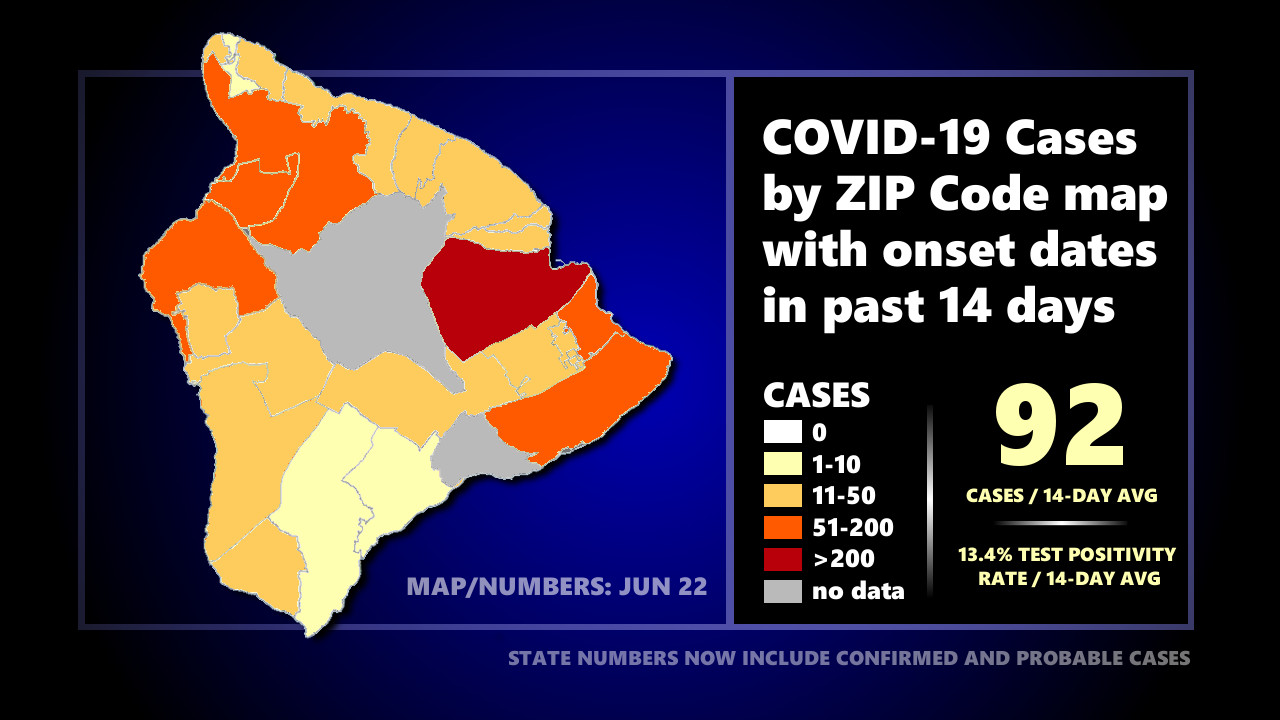(BIVN) – There were 5,482 new cases of COVID-19 identified in the State of Hawaiʻi this week, down from the 7,199 reported last week. Of that number, 579 new cases were identified on Hawaiʻi island, down from the 803 cases reported the week before.
The average test positivity rate on Hawaiʻi island this week was 13.4%, down from the 15.3% reported the week before.
On the Health Department’s zip code area map showing reported COVID-19 cases with onset dates in the past 14 days, there are nineteen (19) zip code areas on the Big Island showing over 11 cases. Zip code areas not listed below have recorded 10 cases or less in 14 days.
- 96720 (Hilo) – 420 cases
- 96749 (Keaʻau) – 140 cases
- 96760 (Kurtistown) – 12 cases
- 96771 (Puna mauka) – 41 cases
- 96778 (Puna makai) – 106 cases
- 96785 (Volcano) – 15 cases
- 96737 (Ocean View) – 14 cases
- 96704* (South Kona) – 20 cases
- 96750 (Kealakekua) – 30 cases
- 96725 (Hōlualoa) – 14 cases
- 96740 (Kona) – 196 cases
- 96738 (Waikoloa) – 64 cases
- 96743 (Kohala/Waimea) – 72 cases
- 98755 (Kapaʻau) – 19 cases
- 96727 (Hāmākua) – 42 cases
- 96776 (Paʻauilo) – 11 cases
- 96773* (Hakalau) – 18 cases
- 96783 (Pepeʻekeo) – 13 cases
- 96781 (Papaikou) – 13 cases
* The 96773 zip code area includes zip code areas 96710, 96774, 96728, 96764, and 96780. The 96704 zip code area includes zip code areas 96726.
UHERO Report Examines Hawaiʻi COVID-19 Impact
From a University of Hawaiʻi news release:
The COVID-19 pandemic has had significant adverse impacts across multiple dimensions in the state of Hawaiʻi beyond the direct effects of the disease itself. According to a new series of Public Health Reports from the University of Hawaiʻi Economic Research Organization (UHERO), almost 2 in 3 adults in the state reported negative effects on mental health, food security, job security, housing and poverty. Almost one in 10 has had a family member die due to COVID-19.
Survey responses for the report were collected in May 2022 and obtained in partnership with the Pacific Alliance Against COVID-19.
“We’ve recruited a cohort of more than 2,000 adults throughout the state to help us understand these issues. Using monthly surveys deployed rapidly to this cohort, we can collect data on health, social factors, attitudes and behaviors over time and monitor changes that could inform public health policy,” said Ruben Juarez, economics professor in UH Mānoa’s College of Social Sciences (CSS) and newly appointed HMSA Endowed Professor of Health Economics at UHERO.
According to the University, some the highlights of the June 20 UHERO report:
- Vaccination rate and booster shots among adults: Hawaiʻi is leading the nation with the highest vaccination rate. More than 93.3% of respondents were vaccinated, while 6.7% remain unvaccinated. Among those vaccinated, 53.4% received one booster shot, 31.6% received two or more booster shots, and 15% have not received a booster shot.
- COVID-19 positivity and estimated immunity: 1 in 4 individuals reported a confirmed COVID-19 positive test. Almost 50% of unvaccinated individuals have been infected with COVID. In addition, individuals who received a booster shot are 46% less likely to be infected than those who did not. It is estimated that more than 95.9% of adults have some degree of immunity to the virus due to infection or vaccination.
- Negative effects of COVID-19 have been very significant in Hawaiʻi’s populations: Almost 2 in 3 adults in the state reported a negative effect of COVI D-19. (23% had their savings depleted, 18% had trouble with the education of their children, 15% were unable to pay rent, 12% were laid off or had their work hours reduced, 12% had a friend who died and 9% had a family member who died.)
- Mental health: More than 1 in 3 adults reported symptoms of depression. 11% of adults reported low self-esteem, and about 4% of adults in the cohort had suicidal thoughts over the last year. Unvaccinated individuals are more likely to experience mental health problems than vaccinated individuals.
- Food insecurity: More than 20% of adults reported low or very low food security. Individuals who got infected with COVID-19 and those unvaccinated, experienced more food insecurity.
- Characteristics of the unvaccinated population: Unvaccinated individuals tend to be younger and have lower education levels than vaccinated individuals. Less than 4% of individuals with a bachelor’s degree reported to be unvaccinated. In contrast, individuals who just completed high school versus those who did not complete high school reported unvaccinated rates of 14% and 41%, respectively.
- Long-COVID: Almost 1 in 3 adults in Hawaiʻi who got infected with COVID-19 experienced symptoms of long-COVID. 58% of the symptoms were cough and shortness of breath. 49% fatigue, 48% mental fog or headaches. 25% joint or chest pain, and 24% loss of taste or smell. The average length of the symptoms differed by vaccination status. Unvaccinated individuals with long-COVID experienced symptoms for about five months post-infection, whereas vaccinated and boosted individuals reported an average of about three months.


by Big Island Video News10:31 am
on at
STORY SUMMARY
HAWAIʻI ISLAND - Reported COVID case counts in the State and County of Hawaiʻi continue to drop on a week-over-week basis.